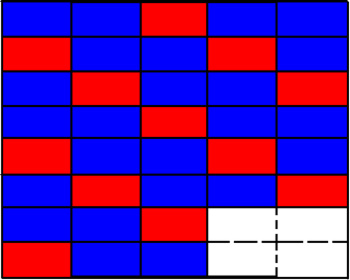Pattern recognition is the ability of the human brain – as well as animal brains – to identify and act upon patterns. This is one of the most fundamental cognitive skills we possess and has historically been highly crucial for our survival and evolution. Specifically, this cognitive process describes the ability to match information from stimuli with information retrieved from long term, short term or working memory.
An example of pattern recognition in animals for instance, is when an eagle see three mice run under a bush. Using basic pattern recognition skills, the bird of prey should be able to tell that three mice will run out the other side with roughly the same time between each one. This will then allow the bird to catch one of the mice by timing its swoop accordingly the other side.
On a more advanced level, pattern recognition may allow us to identify a Fibonacci sequence, to find a solution to a persistent and seemingly abstract problem or to write a computer program. Pattern recognition might even play a role in our appreciation of music!
Models of Pattern Recognition
Interestingly, there are a number of different models of pattern recognition. These include:
Template Matching
Here, incoming information is compared to ‘templates’ of information stored in long term memory. This then is what allows you to say ‘ah, X is just like Y!’. In this scenario you can then proceed to treat X as Y.

Prototype Matching
Prototype matching is similar to template matching except you are not looking for an exact match. For instance, if you see a small chicken you would know this is a chicken (template matching) but you would also know it’s a bird (prototype matching).
Feature Analysis
Feature analysis means that your mind breaks down all incoming stimuli into individual features before processing the information. This model states that our pattern recognition process goes through four stages: detection, pattern dissection, feature comparison in memory, recognition.
False Pattern Recognition
What’s perhaps most interesting about pattern recognition is that it is something that largely occurs unconsciously and automatically. You can actively look for patterns, but it is also happening all the time and allowing you to navigate through the world, make decisions, identify stimuli and basically operate as a healthy human being.
But unfortunately this ‘automatic’ process can also lead to errors and false pattern recognition. This tendency to mistakenly identify patterns is called apophenia and explains why we will sometimes see faces in our wallpaper or why we will think there is a relationship between events when really it’s just a coincidence. Apophenia can even explain our tendency towards conspiracy theories, gambling and several ‘cognitive biases’.
Increasing Your Pattern Recognition Abilities
Can your pattern recognition be improved?
Of course conscious pattern recognition can be improved and this is something that simply takes practice and means looking for those patterns. If you’re struggling with a problem, then break it down into raw data and look for patterns that might help to illuminate a cause and possibly a solution. Find you struggle to sleep? Then start recording when you struggle to sleep most and what other factors could be contributing to that. Once you collect enough data you can then begin to identify patterns and potentially start working towards an answer.
But increasing your unconscious pattern recognition is a different matter. In theory, helping your brain to more effectively identify patterns could increase your reaction times, help you to play sports more effectively and more efficiently. Here are some ways that you can increase your pattern recognition:
Practice With Games
Our brain is constantly analyzing and assessing/responding to patterns as mentioned. However, there are some scenarios which require us to do this more and more quickly with one of the best examples being to play games. Sports involve a lot of rapid pattern recognition as you are constantly keeping tabs on where people are on the court/pitch/field and as you are calculating trajectories of balls and the likely behavior of the opponent all while formulating strategies.
Computer games meanwhile are also very good for pattern recognition as they force you to deal with moving shapes and sounds, to quickly learn rules and to deal with them. When you play a ‘bullet hell’ game (dodging countless on-screen bullets) you literally are looking at the formations of the bullets and anticipating where they are all going to go. When a new ‘boss’ appears on the screen you have to immediately adapt and learn their ‘attack pattern’ to identify openings. Computer games in fact are based on pattern recognition in many cases.
Computer games are actually great for brain training in general and several studies have shown how they can improve vision, memory, problem solving and more besides (1).
Increase Working Memory
Literature on pattern recognition often focuses on our ability to compare what we’re seeing with stored long-term memories to identify patterns. In reality though, pattern recognition is often at its most useful when we’re comparing information as it comes in. In other words, when we’re quickly noticing patterns occurring through our senses.
This requires us to improve our ‘working memory’ which is our ‘shortest term’ memory used to store information that we are currently using (as when we ‘carry over’ numbers in a sum). Increasing working memory is possible with practice and with the use of brain training exercises such as the ‘dual N-back’ test.
Neurotransmitters
Interestingly there may be some neurotransmitters implicated in our ability to recognize and respond to patterns. Specifically it appears that dopamine helps to increase focus and to reduce ‘signal to noise’ ratios, which in turn help us gather more information quickly. Norepinephrine also enhances focus while anandamide increases lateral thinking by increasing the base of reference so that you are more likely to identify unique connections that you might otherwise have missed.
These three neurotransmitters are highly correlated with what is often referred to as the ‘flow state’ – a mental state that appears common to creative individuals when they are producing their best output and to athletes when they are performing optimally.
What causes these flow states? Simple: a belief that what you are doing is highly important, either as a result of an innate passion for your work or because the stakes are high. Extreme sports athletes are some of the most common to experience flow states regularly and this is because the stakes literally couldn’t be higher – they are life or death.
So to increase your pattern recognition you need to increase focus and attention and to do that you need to find what you’re doing fascinating. This means that you will literally do your best work when you enjoy the work you are doing!




